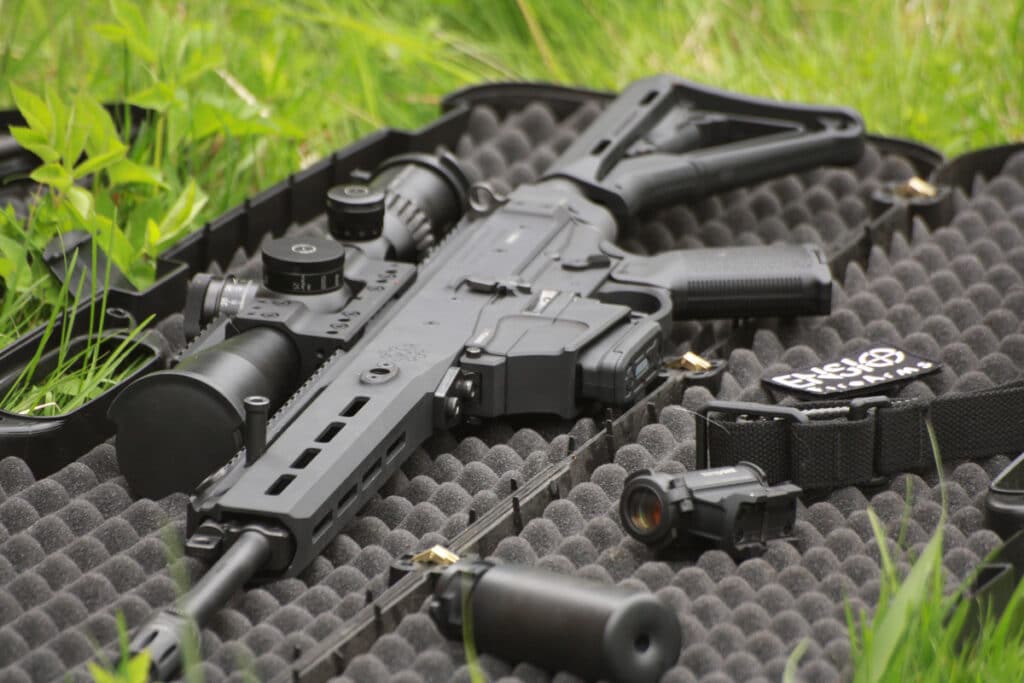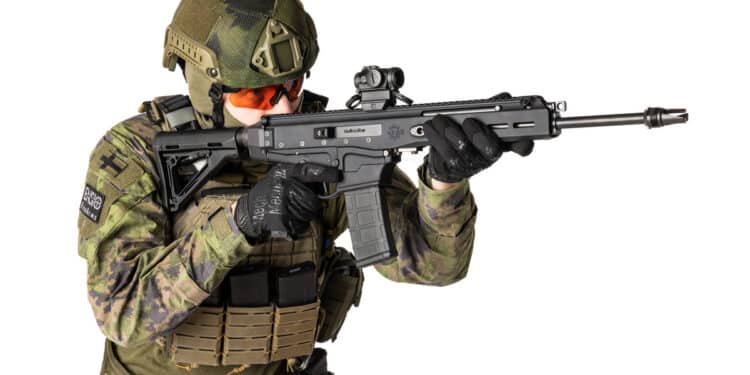By Leszek Erenfeicht
The idea of multi-caliber small arms has just gained another foothold: this new Finnish rifle breaks another barrier by offering one rifle with four-part conversion kits, enabling it to fire two calibers from different power levels: .223 and .308.
So far, the multi-caliber feature in automatic weapons tended to keep to the same power norm: like the ARs and Polish Grot MSBS chambered in 5.56×45, 7.62×39 or .300 BLK. In precious few weapons so far, the caliber selection went down… usually meaning a rifle in 7.62 NATO with a conversion kit to 5.56mm, but still built like a tank and weighing in at what a full-size battle-rifle tends to weight these days, aka the FN SCAR 16(H). Going up, from an intermediate cartridge to full power usually called for designing a sister weapon, usually one size larger, aka the HK417, SCAR 17 or Grot 762N. Now the Finnish designer, Toni Käräjämies might have succeeded to build a rifle weighing in at the same 3.7 kilos (8.15 pounds) with a 16-inch barrel in both calibers. For conversion, one just needs to replace four parts; the barrel group with gas block (for which the only tool needed is an Allen wrench), the bolt, the magazine well insert, and the magazine itself, all replaced at the field-strip level.
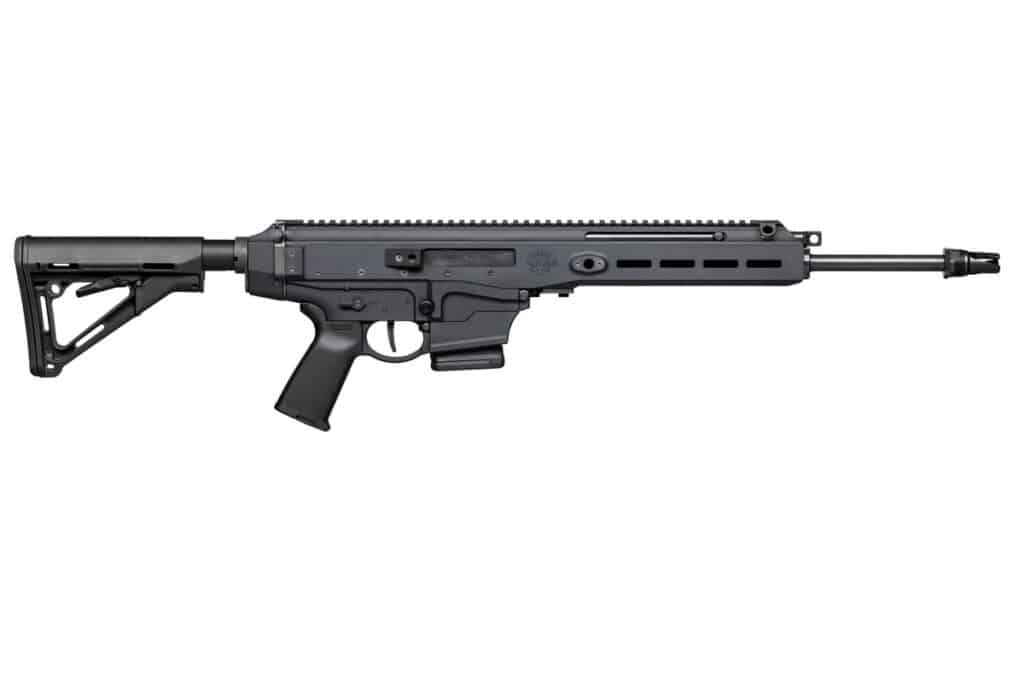
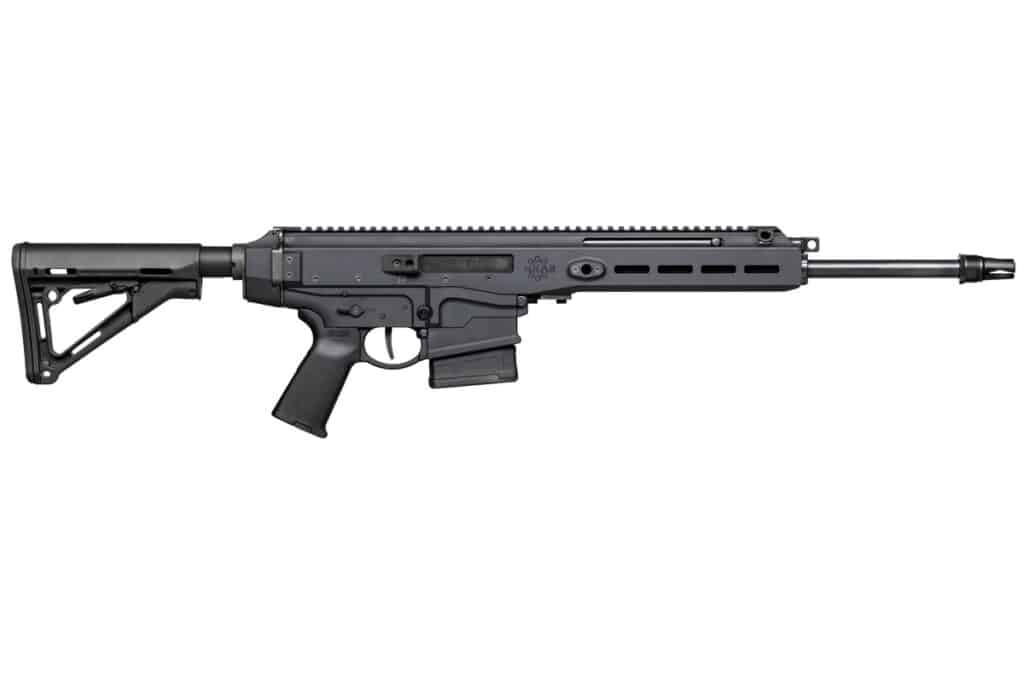
KAR-21
The Käräjämies Automatic Rifle KAR-21 is being manufactured by the company called Ensio Firearms Oy, with Toni Käräjämies as the CEO. The rifle itself is a classic ‘lock, stock and barrel’ gas-operated weapon, locked by a rotating bolt head. The bolt carrier has a cam path inside, into which a single lug of the bolt stem is inserted for turning – anyone that’s seen under the hood of an AK would find nothing unusual here. The Finns do love Kalashnikov – their Armed Forces are still for the most part armed with the Rk-62 milled receiver AK-clone, only partly replaced by the Sako Rk-95, both in 7.62×39. The bolt itself might be actuated in a Kalashnikovian style, but it is locked with multiple lugs inserted into the barrel extension – or “the Stoner way”. The barrel extension is screwed into the breech-end thread, and its bottom part has a transverse groove for the barrel lug. Between the barrel extension and the barrel, a tombstone-shaped plate is squeezed, the top part of which provides an operating rod guide.
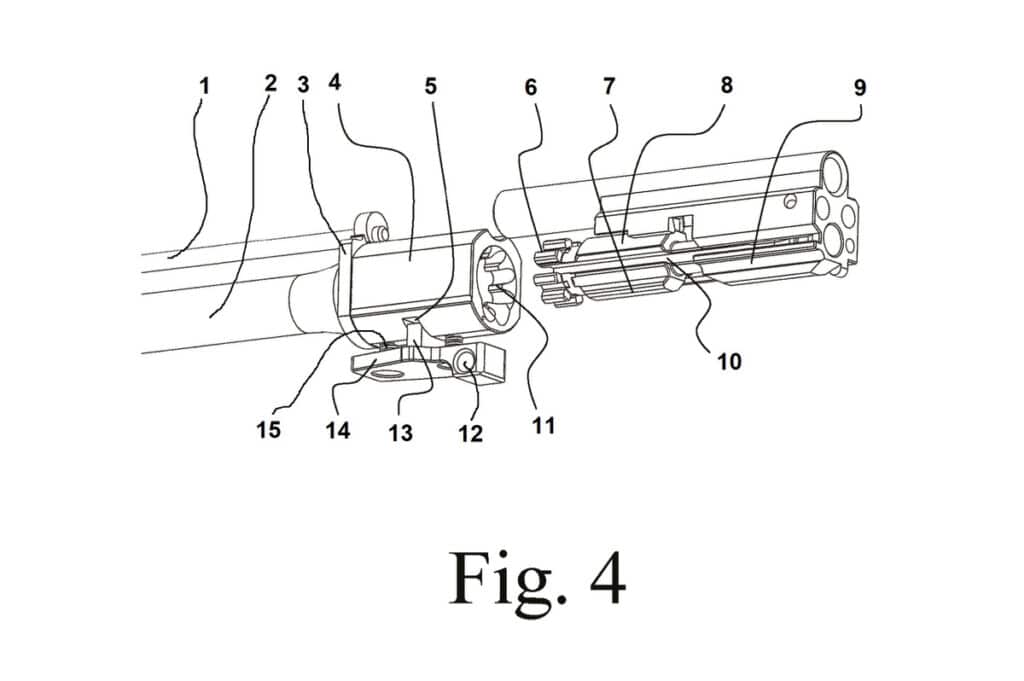
The cold-hammered barrel is easily-exchangeable –as opposed to a QCB. The barrel exchange possibility is a part of the reconfiguration feature, not a tactical one, allowing the exchange of overheated barrels in combat. It’s 16-inch long in both calibers, with extended, 20-inch barrel offered only in 7.62 NATO. The muzzle is threaded 1/2×28 UNEF in 5.56 mm or 5/8×24 UNEF in 7.62 mm, for muzzle devices. Ensio does offer a birdcage compensator allowing QD suppressor hosting with the Ase Utra/Silent Steel attachment.

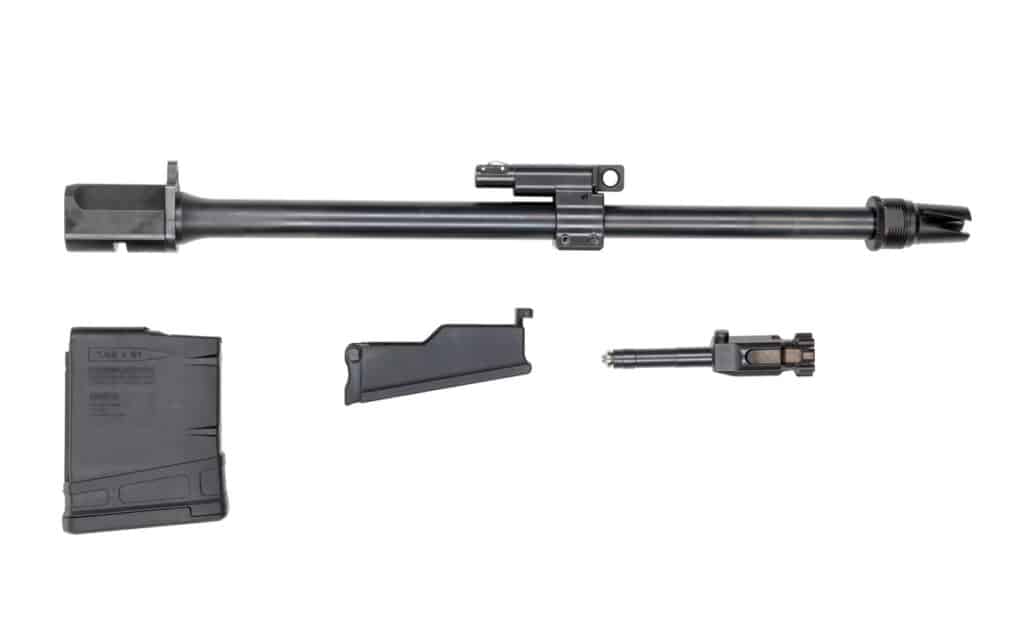
10 inches from the chamber there is a gas block mounted on each of the barrels, holding a gas chamber with a two-setting gas regulator for normal or silenced function. The gas piston is separate from the bolt carrier. Piston and op-rod are one piece, nested in a tube reminiscent of the SKS or Czech SA-58 gas tube, but this is actually moving, acting as a cocking device, connecting the charging handle to the bolt carrier. This cocking tube’s front end is inserted into the gas chamber spigot and held there with a flat spring retainer. Underneath, it has a longitudinal slot, the rear end of which is impaled by the op-rod guide. The transverse channel of the front end of the cocking tube holds a charging handle, which can be inserted from the left or right side. During the reassembly, after the cocking tube is attached, the cocking handle is inserted from either side, and then an operating rod follows through a narrow perpendicular groove in the underside of the handle, thus capturing it in the rifle. So far, the charging handle is straight, but alternative designs, such as an HK G3-style folder, might easily replace it.
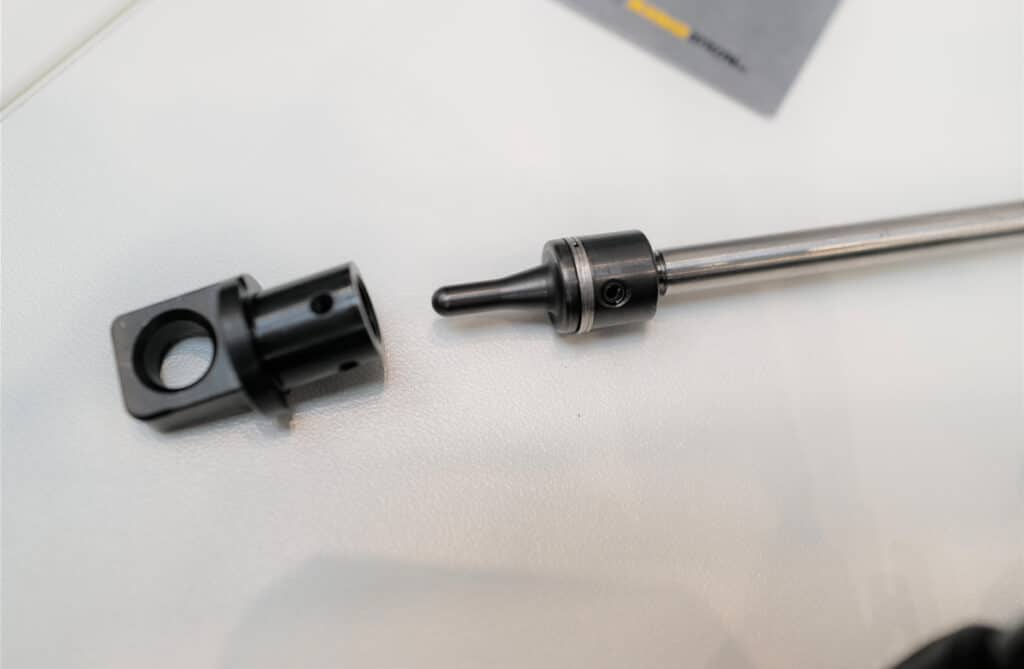
The complete charging unit consists of a charging handle and cocking tube, and only contacts the bolt carrier when retracted – after which it is carried back to battery by the bolt carrier or returned by hand, while the bolt is being held by the bolt-hold-open latch. Unfortunately, this design does not allow the use of the charging handle as a bolt forward-assist, which is possible in Polish Grot or Czech CZ 806 Bren 2 rifles. This feature might come handy in an otherwise suppressor-ready rifle – without forward-assist one has to to reload the rifle by free-slamming the bolt, hardly a silent option. The combination of AK-style bolt actuation assuring increased friction with the AR-locking seems to all but guarantee bolt stalling, should one try to reload it slowly. Perhaps a Scandinavian G3 forward assist style – a ribbed thumb recess in the side of the bolt carrier reachable thru the ejection opening – would be the ticket?
Barrel Exchange
The KAR-21 barrel exchange is very reminiscent of the Austrian Mannlicher Monobloc repeating hunting rifle. The barrel extension has a transverse groove, into which a barrel latch bar is inserted and stabilized with two bolts. The barrel latch and bolts are inserted from the outside, through openings in the bottom of the handguard. At the same time, the rear end of the barrel latch doubles as a trigger frame attachment point, with a mounting pin inserted through the channel formed in its rear edge. To exchange the barrel, one has to unscrew the bolts with an Allen wrench and detach the barrel latch, then pull the barrel out the front end of the handguard. In its present form, that involves detaching small parts (latch and bolts) which might be lost in the process, which is far from ideal. Perhaps the screws should be inserted thru wire or plastic loops to secure them. Perhaps after series production starts, a more elegant solution could be found?
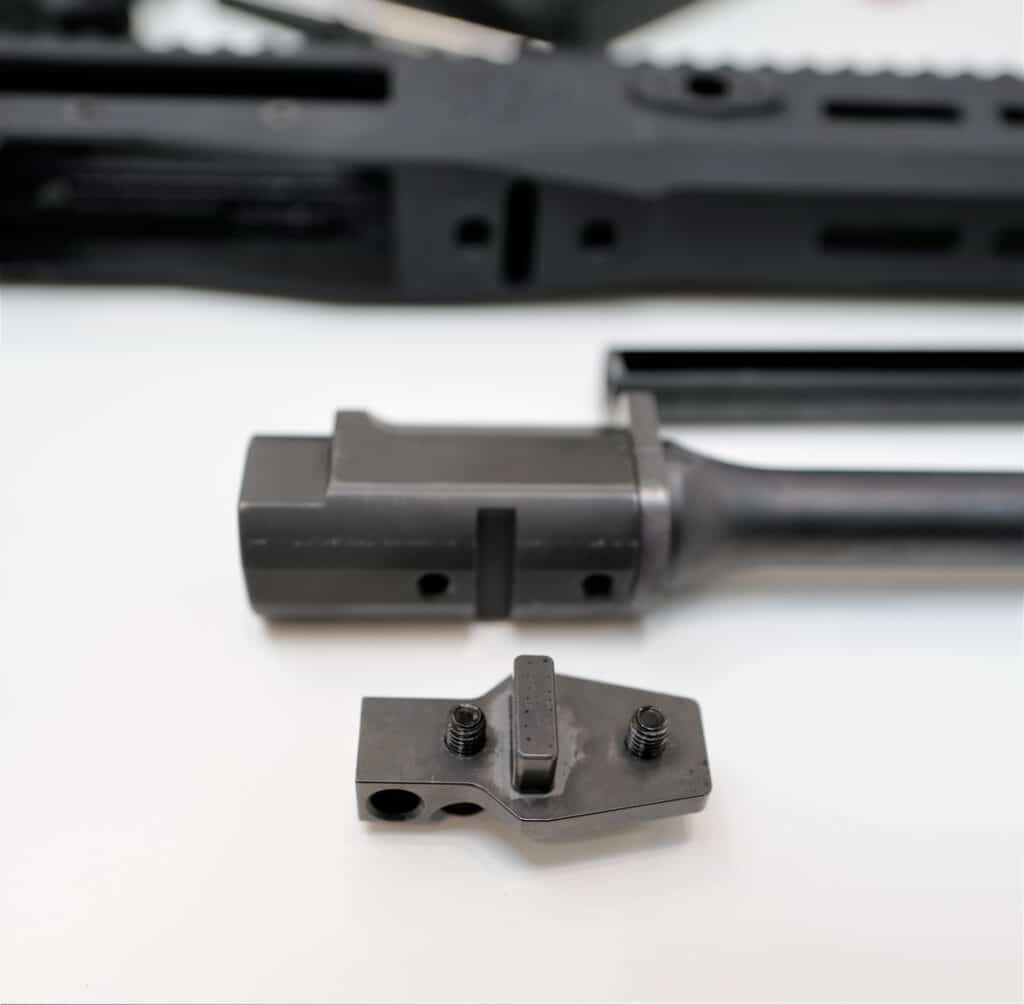
That would leave the question of the barrel latch, as that has to be detached from the fire control group prior to detaching the barrel. The detachment of the trigger frame for caliber conversion is needed anyway, to exchange the magazine adapter, and as a part of the field stripping needed to exchange the bolt.
Fire Control Group
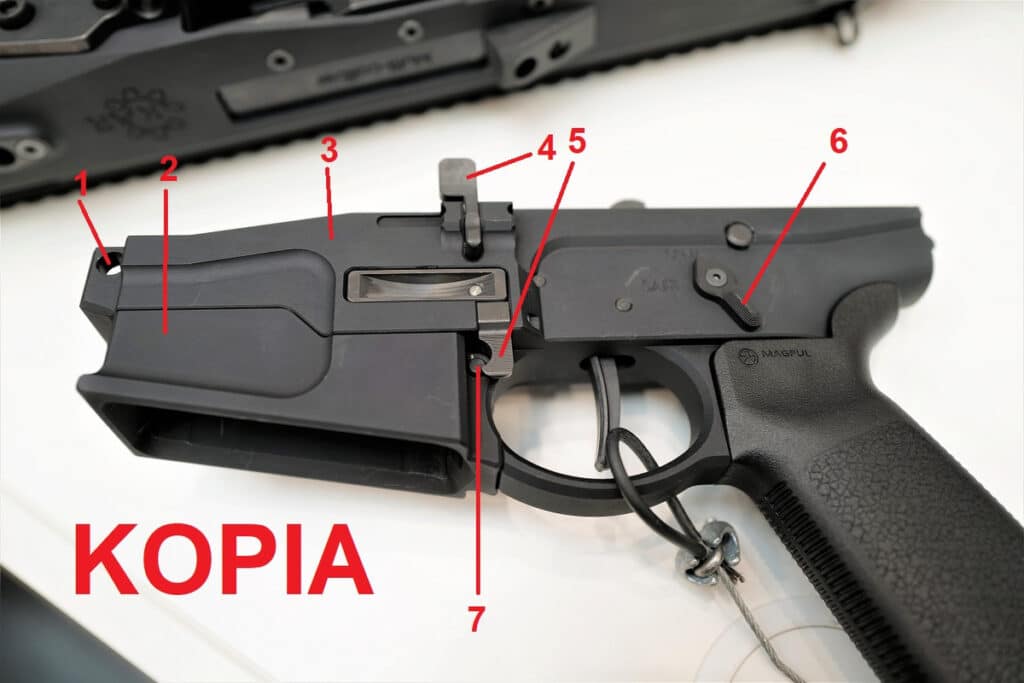
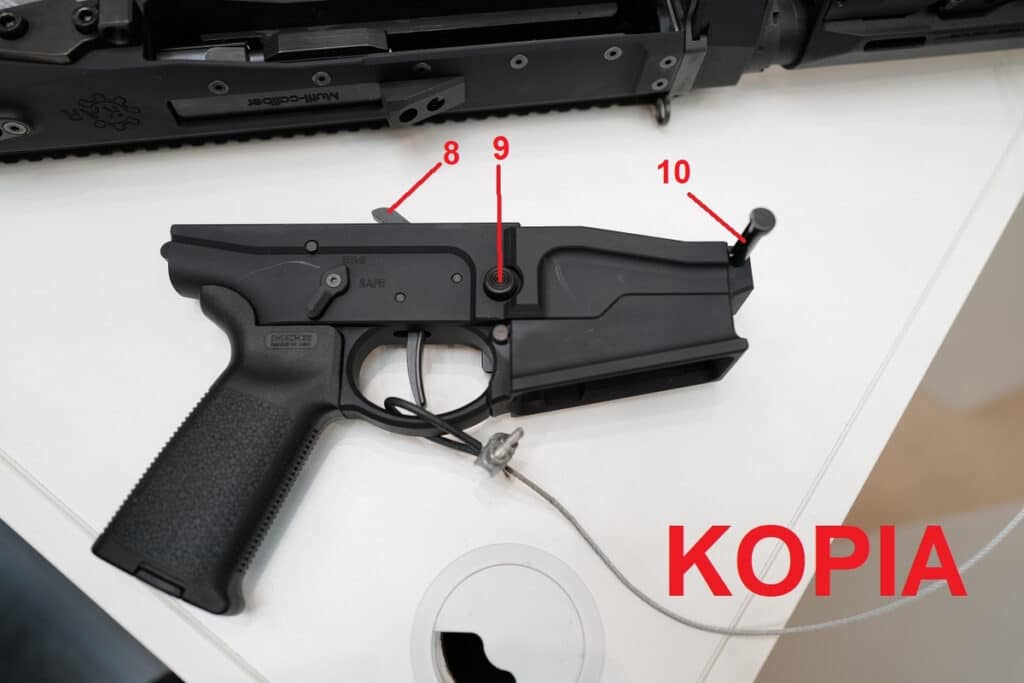
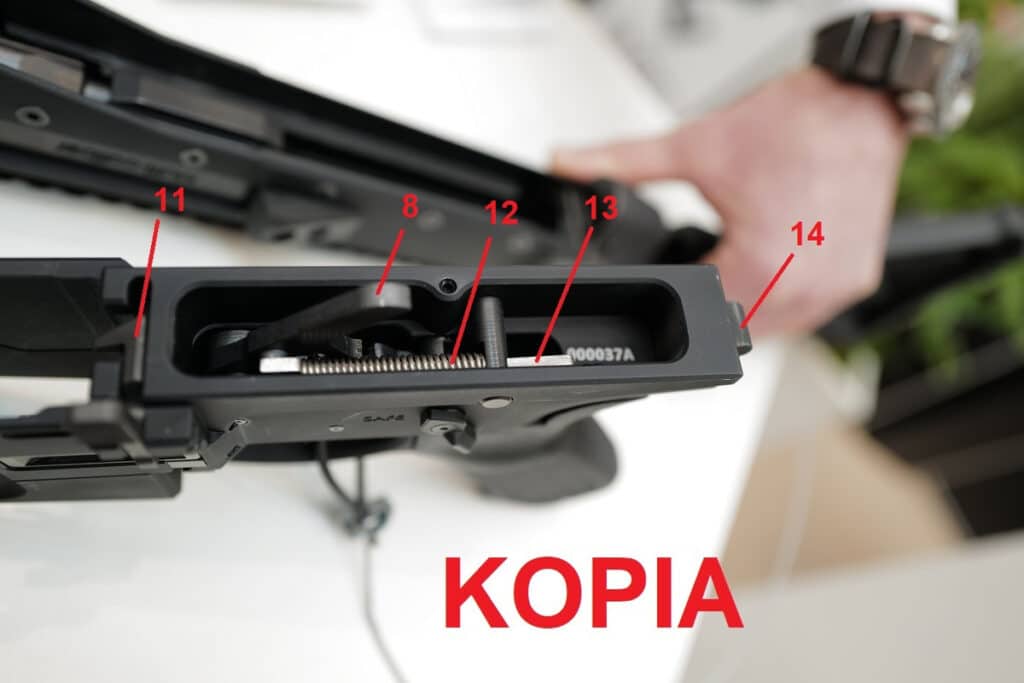
The trigger frame of the KAR-21 can contain two types of fire-control groups, both offered by the company. These are KAR semiautomatic-only FCG with a 45-degree throw two-position safety (SAFE-SEMI), or selective fire KAR-A (for automatic) with a 45-degree throw three-position safety-selector (SAFE-SEMI-AUTO). The trigger frame is compatible with standard AR-style grips and stocks. Its front part, around the magazine well, houses a magazine adapter, which is weaved thru the grip frame from the bottom and secured with a mounting pin going through the rear part of the adapter and front of the trigger guard. The outer part of the magazine well is fixed and houses the ambidextrous AR-style magazine release and BHO. The magazine well is large enough to fit around the magazine insert, taking the AR-10/SR-25 magazine of the 7.62 NATO configuration. Each of the adapters has different inner measurements to fit AR-15 and AR-10 magazines, while assuring the case head of the topmost cartridge is in the same place, to assure the proper function of the AR-style BHO lever.
Handguard? What Handguard?
The receiver is monobloc, with the rear part open from both ends and the bottom, seamlessly morphing into integral handguard (Finnish design 008476634-0001.) The handguard part of the receiver has got a row of four M-LOK slots at the bottom and both sides, providing both ventilation and real estate for mounting accessories. At each side, behind the slots, a sling QD point is attached with additional oblique QD points extending from the front ends of the top Picatinny rail. This is in addition to carbine hook openings at the rear end of the top rail. Other than that, KAR-21 stock has additional QD points and sling slots.
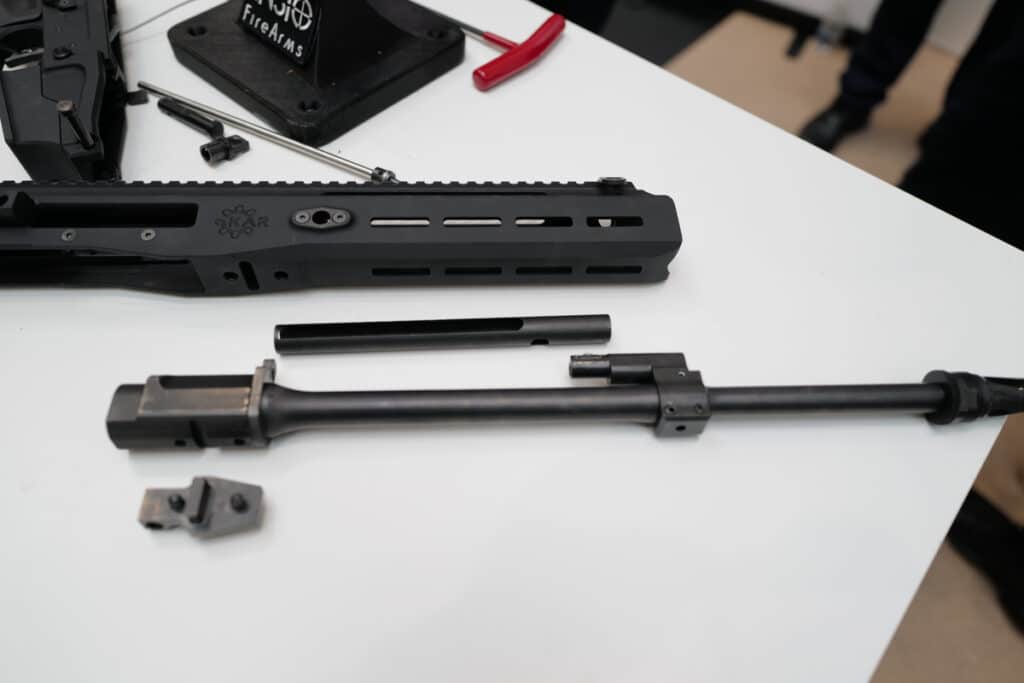
The whole upper part of the rifle, receiver, and handguard alike is topped with a full-length STANAG 4694 (Picatinny) mounting rail, assuring enough real estate to attach any combination of sighting devices the shooter is able to lift – be it mechanical, optical or optronic devices.
Field Stripping
To clean after firing or to change caliber, the KAR-21 requires a field stripping. After clearing and checking the rifle, first, the hammer should be cocked (if it was released during checking). Then the FCG mounting pin should be withdrawn, and FCG detached by rotating it down around the rear end – just like in CZ 806 and FN SCAR. Detaching the FCG means removing the projection, retaining the buttstock mount in the rear trunnion, which can now be slid downwards from the trunnion guides. Now that the stock is detached, the return spring group can be withdrawn from the receiver. With the spring out, the moving parts slide out of the receiver. Turning it upside down allows the bolt to rotate until its lug exits the bolt carrier’s cam path, letting the bolt slide forward and out out of it – just like in AK.
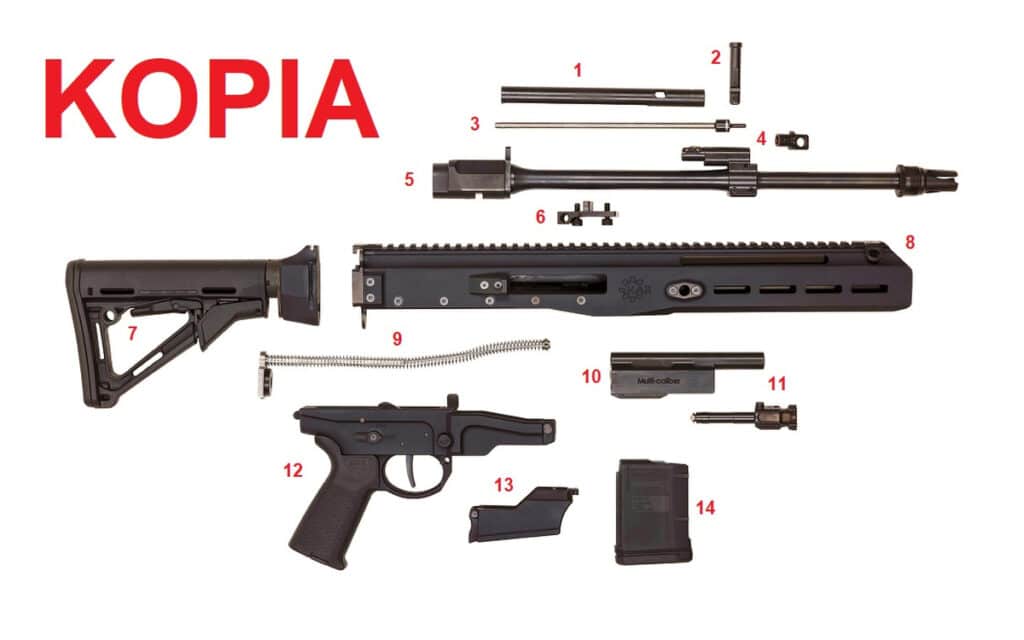
To detach the gas mechanism, first the gas regulator is rotated to the dismounting position and taken out. Then, tilting the rifle muzzle down lets the gas piston and op-rod to fall out. After that, the charging handle is withdrawn from the side. The cocking tube stays put for a while – this can be detached only after the barrel is detached.
The barrel is removed next by removing the bolts and withdrawing the barrel latch, then pulling the barrel out of the handguard from the front. Now the cocking tube can be lifted and pulled back from the gas chamber spigot. If the barrel was taken out for caliber/length exchange, the cocking tube should be first replaced to the new barrel.
Similarities And Differences
Stylistically, the KAR-21 seems to have much in common with the Polish Grot – or perhaps their mutual inspiration, the Remington ACR. Aluminum receiver with a long monobloc Picatinny top rail, it has steel bolt rails inside attached from the outside with very visible screws – actually more screws than the Grot, which is an achievement in itself. The monobloc receiver reminds one of another rifle recently introduced by a Baltic neighbor of Finland – Estonia, which has lately replaced its hodge-podge of rifles with an LMT Mars variant, the R20 Rahe. The single front mounting pin attached, back-swinging trigger frame reminds one of the FN SCAR and Czech CZ 806, both of which feature this – as well as the FCG with a long, side-mounted horizontal hammer spring with a strut.
The stock is rail mounted, and can therefore take any shape needed, as long as it conforms the receiver. In the first models an M4-style Magpul CTR telescoping stocks were used, but as there are no return springs filling the stock tube, it should prove replaceable with a different model (preferably a side-folding and telescoping) without much ado. By the way, the return spring on the KAR-21 return group is a dead ringer for the AKM wire-loop rod, only it has a tombstone-shaped rear support with an enormous polymer bolt bumper.
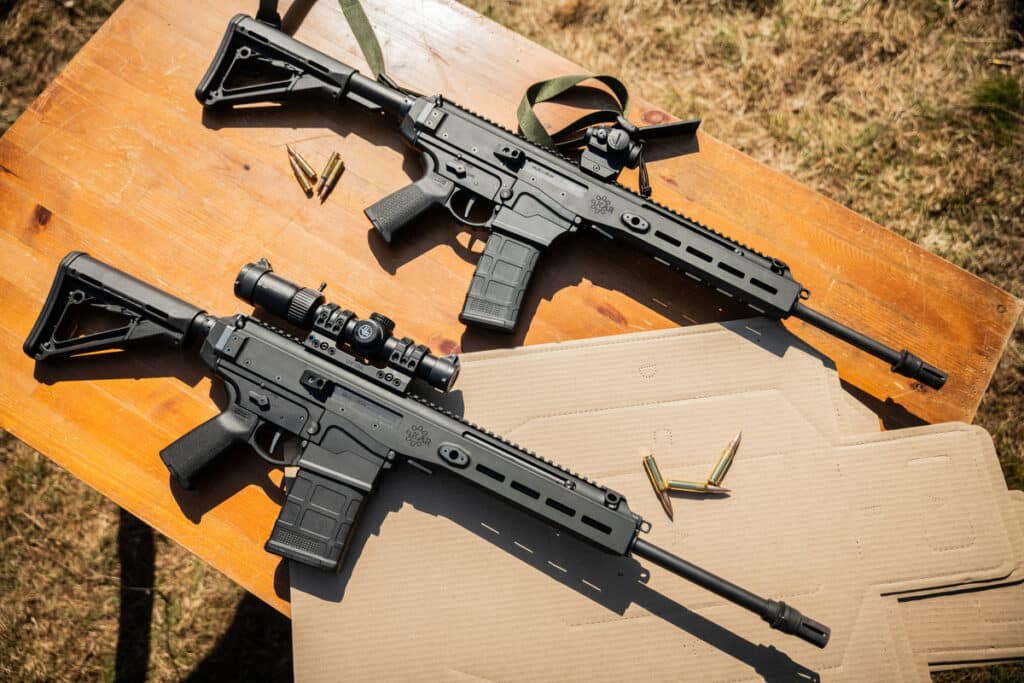
Also, the moving parts are AK-esque, as already pointed out, even though the multiple locking lugs are AR-style… while the piston-less bolt carrier looks rather Dragunov SVD-ish (sans bolt handle). The ejector is fixed to the left bolt rail, again indicating that someone here has seen an AK. That fixed ejector paired with a wide AR-style extractor should be an improvement upon both.
There’s only one ejection opening (on the right-hand side.) And that’s enough for most users, at least in a lock, stock, and barrel configuration – fortunately bullpups are not announced, so far. Borrowing a term from the 45th President would be the only way to briefly describe the brass deflector just outside the ejection window – it really is HUUUGE. The size of it gives one a hint of what is going there, when the 7.62 NATO brass is flying.
An interesting feature of the KAR-21 is compensating the length of the cartridge by a different length of the bolt for each caliber, keeping the bolt carrier stroke uniform.
Let’s Wait and See
What good, if any, this rifle will bring, only the future can tell. It is an interesting mix of AK and Western influences, but so far all we have to munch on is a Finnish patent FI20215347 plus company photos and several trade fair snapshots. The real test will be in the practical use of mass-produced rifles by the public. The identical weight and stroke of the moving parts in both calibers seems particularly foreboding, with excessive speed with 7.62 NATO very probable, limiting the service life of the rifle. That ginormous bolt bumper on the return spring support does not seem to be there solely for decorative purposes. That bodes darkly for the military use of the rifle, together with lack of strongpoints for UGL attachment – but perhaps some law enforcement use is still a strong possibility.
Anyway, hardly a week after the IWA 2023 tradeshow, Finnish and Swedish armies announced their new common rifle system to be the AR-style Sako Kiv-23 in 5.56 and a BR/DMR T-Kiv-23 in 7.62 NATO, which seems to cull the KAR-21 from hopes for service use rather harshly. But it would probably make a big wave on a civilian market, especially in those countries where a number of long arms possible to get by one individual is severely limited. Here, with just one rifle and two conversion kits, featuring lots of attachment possibilities for any sight in existence, one can have a universal weapon for the two most popular tacticool cartridges, perfectly useful for all the cardboard assassins, and killing scores of metallic gongs. What’s not to like?
SPECIFICATIONS
| Make: | Ensio Fire Arms Oy | Ensio Fire Arms Oy | |
| Model: | KAR-21 223/556 | KAR-21 308/762 | |
| Caliber: | .223 Rem / 5.56 NATO | .308 Win / 7.62 NATO | |
| Barrel length: | 16 in | 16 in | 20 in |
| Overall length: | 849 mm (33.4 in) | 865 mm (34.1 in) | 965 mm (38 in) |
| Weight: | 3.7 kg (8.16 lb) (all models) | ||
